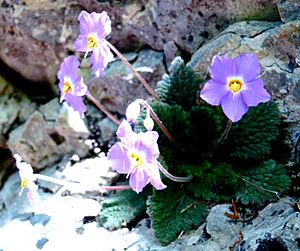Pyrenean-violet facts for kids
Quick facts for kids Pyrenean-violet |
|
|---|---|
 |
|
| Scientific classification | |
| Genus: |
Ramonda (plant)
|
| Species: |
myconi
|
| Synonyms | |
|
|
Ramonda myconi, also known as the Pyrenean-violet or rosette mullein, is a beautiful flowering plant. It is a special type of plant that grows in the rocky, shady areas of the Pyrenees mountains. These mountains are located between France and Spain. This plant is unique because it is an "evergreen perennial." This means it stays green all year and lives for many years.
Contents
About the Pyrenean-Violet
Where It Lives
The Pyrenean-violet is a "Mediterranean endemic species." This means it naturally grows only in this specific part of the world. It is found in the rocky areas that form the border between France and Spain. It loves shady spots among the rocks.
What It Looks Like
This plant forms a "rosette," which means its leaves grow in a circular shape close to the ground. It can grow to about 10 centimeters (4 inches) tall and 20 centimeters (8 inches) wide. Its leaves are oval-shaped and have a crinkled texture.
In the spring, lovely purple flowers appear on stems that have no leaves. Each flower has five petals. They also have bright yellow parts in the middle called anthers.
A Special "Resurrection" Plant
Ramonda myconi belongs to a special group of plants called "resurrection plants." This is a very cool ability! It means they can survive even when they become very dry. They can tolerate severe drought conditions. When water returns, they "come back to life" and become green again.
Growing This Plant
People sometimes grow the Pyrenean-violet in gardens. It does best when planted in vertical cracks in rocks. This helps its roots stay dry during wet winters. This plant is so special that it has won an award. The Royal Horticultural Society gave it their "Award of Garden Merit." This award means it is an excellent plant for gardens.
See also
 In Spanish: Ramonda myconi para niños
In Spanish: Ramonda myconi para niños



